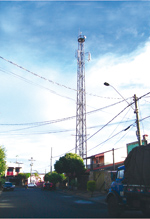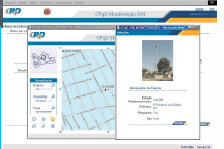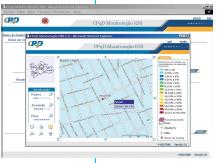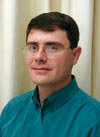WIRELESS COMMUNICATIONS
Controlling radiation to protect health
By Luiz Carlos Neves and Antonio Marini de Almeida
The boom in mobile telephony has triggered demand for more transparency in providing
information to the public about the levels of electromagnetic radiation emitted
by base stations of wireless communication systems. The long-term effects of electromagnetic
radiation on human health are still under research. Nevertheless, a key question
for many people worldwide is what controls are exercised over these radiation emissions.
To address this concern, Brazil has developed a system that allows local authorities
in a city to manage radiation levels produced by telecommunication infrastructure
and gives the public access to this information through the internet. The system
also offers objective information to validate and improve the criteria for planning the expansion of mobile telecommunication infrastructure. This article highlights
Brazil’s experience with this new approach to controlling electromagnetic radiation.
| |

CPqD |
| |
A mobile communications base station in the city of Americana, Brazil
|
The example of Brazil
Telecommunication indicators for Brazil reveal just how important mobile technology
has become: the five years between 2001 and 2005 saw a growth of 270 per cent in
the number of mobile handsets. According to the Indicators 2006 report from
Brazil’s National Regulatory Agency for Telecommunications (Agência Nacional
de Telecomunicações — Anatel), by 2005 there were 86 million mobile subscribers
nationwide, compared with 42 million fixed lines. This spectacular growth is associated
with the significant expansion of the infrastructure for mobile telephony, including
an increased number of radio base stations, antennas and towers installed in urban
areas. Service providers try to optimize their investment by installing towers on
small lots or in areas shared with residences, and even near schools. Increasingly,
though, such changes to the environment have provoked reactions among local people
regarding the location of radio towers, the impact on the landscape, and concerns
about risks to human health.
Many Brazilian cities have now established rules that limit radio station installations
in urban areas. Also, there is a national regulation establishing limits for electromagnetic
emissions, based on the International Commission on Non-Ionizing Radiation Protection
(ICNIRP) guidelines. However, due to the lack of a device to demonstrate that the
levels of radiation are within permitted limits in the vicinity of a radio tower,
the number of lawsuits has risen. Alongside municipal laws to slow down installations,
this significantly complicates expansion projects.
 |
|
| A page on the internet site of the monitoring system, showing data from one radio
station on a street map of Americana. By clicking on the station icon, a new window
appears with details of its name, address, owner and construction type
|
|
To deal with this situation, a research-and-development project was launched
in 2004, financed by the Brazilian Telecommunications Technological Development
Fund (Fundo para o Desenvolvimento Tecnológico das Telecomunicações — FUNTTEL),
and conducted by the Center for Research and Development in Telecommunications (CPqD).
The aim was to find a way to disseminate up-to-date, trustworthy information on
wireless communications.
Designing a solution
The situation in Brazil, as well as experience in other countries, shows that
more must be done to tell people about the effects of technology, and to make procedures
for monitoring these effects more transparent and understandable. This is also the
recommendation of the World Health Organization. The Brazilian public was not sufficiently
informed about changes in their environment, and, often, people did not receive
a satisfactory answer when they did ask for details of new installations. At the
same time, technical complexities prevented local authorities from demonstrating
that the relevant legislation was being obeyed and that existing radio stations
were being properly controlled.
The answer was to create a system that people can trust to provide them with
accurate information they can understand. For a developing country especially, the
system had to satisfy the following requirements:
- Personnel without a background in telecommunications must be
able to manage the system.
- It must be possible to evaluate the radiation emitted by a group
of installations, and the changes that would be produced by a new installation before
authorizing its implementation.
- Local residents must have access to the system and information
on control of radiation limits, in clear, easily understood language.
- The technological resources employed must require a limited
amount of investment and must be easily maintained.
Online monitoring made possible
The monitoring system that was developed in Brazil performs continuous measurements
and simulations of the intensity of non-ionizing radiation (NIR) produced by base
stations of wireless telecommunication systems. The system allows users to see,
via the internet, a map of actual electromagnetic emissions in their city, or to
examine simulations of the emissions from changes to the wireless network.
| |
 |
| |
The map shows icons of a base station, a remote measuring unit and an indicator
of radiation levels. The colour chart on the right indicates bands of radiation
limit percentage |
Known as CPqD NIR Monitoring, the system has an internet server and database,
a map server, an interface to control remote radiation monitoring units, and diverse
clients. The data regarding radiation levels are graphically illustrated on maps
as percentages of the permitted radiation limit. The software modules were developed
using open-source tools, in order to create a system with low investment needs.
A device was developed to allow remote measurements. It is composed of an electromagnetic
field sensor and a control module that performs periodic measurements and transmits
them to the system via the mobile phone network itself.
Pilot project in Americana
The system was tested in the city of Americana, in Brazil’s state of São Paulo,
in order to validate and improve it. Technical data and information on the location
of radio stations was obtained from the city’s authorities and from Anatel.
The layout of streets in Americana was obtained from a digital map that also
includes information on railways, main highways, public squares, city districts
and city landmarks. Photographs of the base stations for mobile communications were
also provided. For each station, the system records its owner’s name and address,
the geographical coordinates, technical characteristics of the antennas (model,
gain, height, azimuth and mechanical tilt), frequency and power of each of the installed
transmitters, number of carriers, and losses in the means of transmission. Effectiveness
of this simulation process was proved through field measurements carried out at
all base stations in the city of Americana.
| |
 
Luiz Carlos Neves and Antonio Marini de Almeida, CPqD Telecom and IT Solutions,
Telecommunications Research and Development Center, Campinas, São Paulo, Brazil |
The system allows citizens to query existing installations in the city and to
measure radiation emissions and simulated values of emissions by simply clicking
a base station’s location on a familiar street map. Access to the online system
was made public in December 2004, via the websites of the local government and of
CPqD.
Thanks to the new system, public authorities in Americana now have better
control over the radio stations installed in the city, and local people can obtain
information about the levels of radiation. The system has contributed significantly
to lessening conflicts among interested parties, regulatory bodies and service providers
of mobile communications. Americana is now considering a change in its municipal
legislation, which would establish criteria for the installation of base stations.
The radiation monitoring system developed in Brazil seems to have demonstrated
a successful way of maintaining a balance between allowing the expansion of wireless
access technologies, while enabling the community to exercise control over possible
adverse effects of the use of certain technologies on a broad scale.
|


